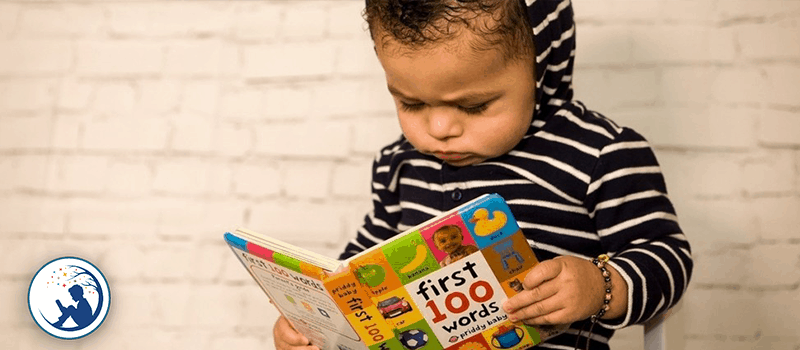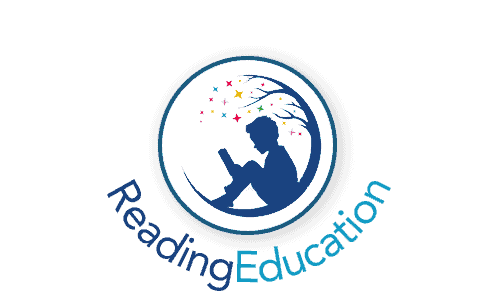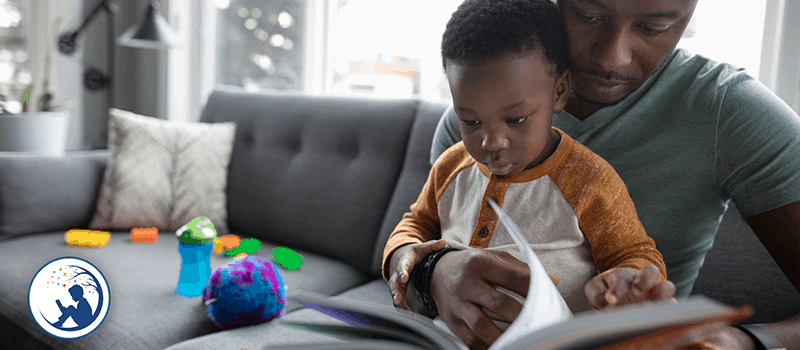In today’s piece, we’re going to delve deeply into the world of teaching toddlers to read.
We’re going to answer by far and away the most commonly asked question in relation to teaching toddlers to read, examine at the complex processes involved in learning to read, discuss how toddlers develop (and how you can use this to your advantage when teaching them to read), and furnish you with our top tips and activities for facilitating early reading skills in pre-school children. So, if you’re a parent who’s keen to promote learning from a young age, this is just the article for you.
Teaching a toddler to read – is it possible?
A Google search for anything related to teaching toddlers to read will throw up a real mixed bag of contrasting information. A mere scratch of the surface will provide you with all manner of opinions from across the vast reaches of the spectrum, with proponents from both sides stating why they’re right and why you either should or shouldn’t teach your toddler to read. The question is, who should you believe? What is the actual answer to this question?
To save you going down any form of toddler reading-related wormhole, we’ll put it in plain and simple terms for you here. The answer to this question is both ‘yes’ and ‘no’. Let us explain why.
There are a plethora of variables and factors involved in the process of developing reading skills. While it is true that some toddlers may pick up certain skills early on, this isn’t necessarily the same for all children. Plus, what some parents may interpret as their toddler reading may merely be recitation, mimicking or something else of that nature.
Of course, this doesn’t mean that you can’t or shouldn’t expose your son or daughter to books, reading activities, word games, the alphabet, and anything else reading/word/letter related. After all, exposure to such activities and reading ‘lessons’ will no doubt have a positive effect on their development over both the short- and long-terms. However, before beginning your child’s reading ‘journey’, it’s essential to understand that learning to read is an intricate process that involves the mastery of many abilities. To give you a better understanding of these, let’s take a look at the individual components of the ‘learning to read’ process.
Comprehension: Comprehension is a huge part of reading. While a toddler may have the ability to understand the sounds of letters and letter combinations and combine words in isolation, comprehension ability enables a child to both understand and interpret the words they’re reading, i.e. make connections between the words and the world around them.
Phonics: Often consumed with phonemic awareness (see below), phonics is actually slightly different. Phonics means that a child is able to identify the sound letters make both individually and when combined with other letters when written down (often termed the sound-symbol relationship).
Phonemic awareness: Phonemes are the sounds that represent letters. A child who has phonemic awareness has the ability to understand all of the different letter sounds. Unlike phonic awareness, this doesn’t involve letters written down and is instead an auditory skill.
Vocabulary: This is the ability to connect words with the objects, people, places etc. in the surrounding environment. Vocabulary is essential to reading as in the early stages; it helps toddlers and children understand word meaning, then later down the line allows them to understand full sentences.
Fluency: Reading fluency is concerned with reading accuracy (reading a word correctly or incorrectly) and reading rate (the speed at which a child reads, measured in words per minute). The way a child phrases words, known as intonation, and adopting different voices and accents for characters are also elements of fluency.
Toddler Development: What You Must Know

The most crucial aspect of toddler development that all parents must be aware of is the fact that all children develop at varying rates. No two toddlers will ever develop in exactly the same way through exactly the same time frame. Yes, I’m sure we’ve all had a friend or friend of a friend who informs us that their two-and-a-half-year-old offspring is reading books designed for five-year-old, but it’s essential to know that this certainly isn’t the norm and, most importantly, you should not expect this level of reading ability from your own toddler. To illustrate this, let’s take a look at a few facts:
– The majority of children learn to read between the ages of six and seven.
– Some children may get to the same level of reading ability by the age of four or five.
– A very small number of children learn to read before the age of four.
What can we glean from the above facts? Well, whilst it is certainly possible for a toddler under the age of four to read, it doesn’t happen all that often.
But why is this?
I think saying that the majority of parents won’t begin teaching their child to read before the age of three is a fair assessment to make; therefore, the above stats would probably different if every single parent started teaching their toddler to read at the age of one. However, what’s most important here is to firstly, make learning fun, and secondly, start teaching your toddler to read whenever you want to; it’s entirely up to you.
Nevertheless, before we get ahead of ourselves (“Walk before one can run” is an apt idiom here!), it might be wise to take a step back and break down toddler (reading) development into four main areas. Literacy in toddlers doesn’t automatically equal the ability to read, so let’s take a look at several skills that toddlers can and will develop prior to reading. It’s crucial to understand this as it will allow you to assess how far your toddler is developing accurately.
Toddler development is often referred to as a dynamic process that happens in stages. Here are a few examples of skills that toddlers are able to develop:
Book handling: How to hold and handle books, e.g. learning not to chew/rip them and how to turn pages.
Seeing and recognising: As toddlers get older, their attention span increases. Babies typically don’t engage with what’s actually on the page; however, as they get older, they will better connect with pictures and images, often pointing to the object that they recognise.
Comprehension: As mentioned above, comprehension is an integral part of the learning-to-read process. It is, in short, the understanding of books, i.e. words and images. As this skill develops, you may see your toddlers talk about things they heard in a story or even act them out.
Reading behaviours: Toddlers will often verbally interact with the books you read to you. This commonly takes the form of mouthing words or babble when being read to or imitating you as you read. Some children might even run their finger under the words as you read to them.
As time goes by, your toddler may have the ability to recognise their own name or even recite a whole book from memory. Does this mean they’re ‘reading’? Not necessarily; your child may merely be reciting the words that they’ve seen and heard many times over; however, this is an integral part of the learning-to-read process.
Teach Your Toddler To Read: Eight Fun Activities

Ok, so now we’ve discussed what toddler reading development entails, it’s now time to furnish you with activities and games that are perfect for teaching young infants about reading, words, letters, and language. Helping your toddler to develop is about being pro-active; the more activities, games, and learning strategies you incorporate into their daily lives, the quicker they will develop.
#1 – Reading Together
Even really young children will benefit from being read to – particularly if it’s part of their daily routine. The more often reading happens, the quicker children will acquire the other fundamentals of reading (comprehension, phonics, phonemic awareness, vocabulary, and fluency). When choosing books to read to your child, encourage their input. Reading will be more and enjoyable for them if you read books that contain stories or topics they’re interested in.
#2 – Ask Your Child Questions
Developing your child’s literacy skills requires more than just reading; it involves the use of language too. Therefore, talking to your child about what is happening in a book and asking them to tell you what’s happening in the story, who the characters are and what they think of them, what they think might happen next, and questions of the ilk are essential to development. Why not ask them to tell their own stories? Always incorporate new words, phrases, and vocabulary when speaking to your child. Even though they may not instantly understand what a particular word or phrase means, exposure to new words is another crucial part of development.
#3 – Letter Sounds
The world around us is full of words; they’re everywhere you go, which gives you an almost infinite number of opportunities to help your toddler develop their reading and language skills. For example, whenever you see a word that you think may interest them or has some relevance to their hobbies, point it out and spell it aloud for them, letter by letter. Remember, words don’t just appear in books, so make use of the constant flow of language us on a daily basis to help facilitate learning.
#4 – Text Games
Don’t just stop at pointing out and spelling words that you see in the world you; turn it into a game too! For example, if you’re visiting the grocery store, ask your child to tell you the first letter of the store’s sign or a word on a piece of food packaging. Games like this are fun to play and can really boost your toddler’s letter and word awareness and recognition.
#5 – Technology Is Your Friend
There are a wide array of highly beneficial apps you can use to help introduce or cement reading skills. Don’t be afraid of using technology to help your child develop; contrary to popular belief, it does have more advantages than disadvantages. However, it is vital to the remember that research suggests that children under two years of age should not be exposed to digital media, and those aged between the age of two and five should have screen time limited to no more than 60 minutes per day (https://www.aap.org/en-us/about-the-aap/aap-press-room/news-features-and-safety-tips/Pages/Children-and-Media-Tips.aspx).
#6 – Label Everything!
Toddlers typically spend more time in the home environment than anywhere else, so be sure to turn your home into a learning paradise! You can do this by making labels for various things around your house, such as the television, fridge, sofa, tables, chairs…even people! Once your child becomes accustomed to these labels, take them off and ask them to put them back in the right place. Begin this with just one or two words, building it up to 10 or even twenty words as their reading and literacy skills develop.
#7 – Songs
Everyone loves a sing-along, but did you know singing songs can help your toddler to learn? Singing is the perfect way to work on your toddler’s literacy skills. Start with simple alphabet songs to acclimatise your child to letters of the alphabet, then sing absolutely anything you like provided it involves basic words and phrases and incorporates the world around you.
#8 – Rhyming Games
Playing rhyming games is another fun way to help your toddler boost their literacy skills. Whether you’re in the car, waiting in line in a coffee shop, grocery shopping, or just out and about, ask your child to name words that rhyme with something they’ve seen. For example, if you’re out taking a stroll, and see a tree, ask them to think of words that rhyme with ‘tree’.
How To Teach A Toddler To Read: A Summary
While it is fair to say that introducing a toddler to words, letters, and language at an earlier age may speed up their development, it doesn’t always guarantee it. Therefore, It’s crucial not to get bogged down with attaining specific goals within a particular time period or by a certain age. Although toddler development is, without doubt, a complex, intricate, and gradual process, that doesn’t mean that it can’t be fun. In fact, that should be your sole aim when teaching your child anything – make sure they enjoy it!

